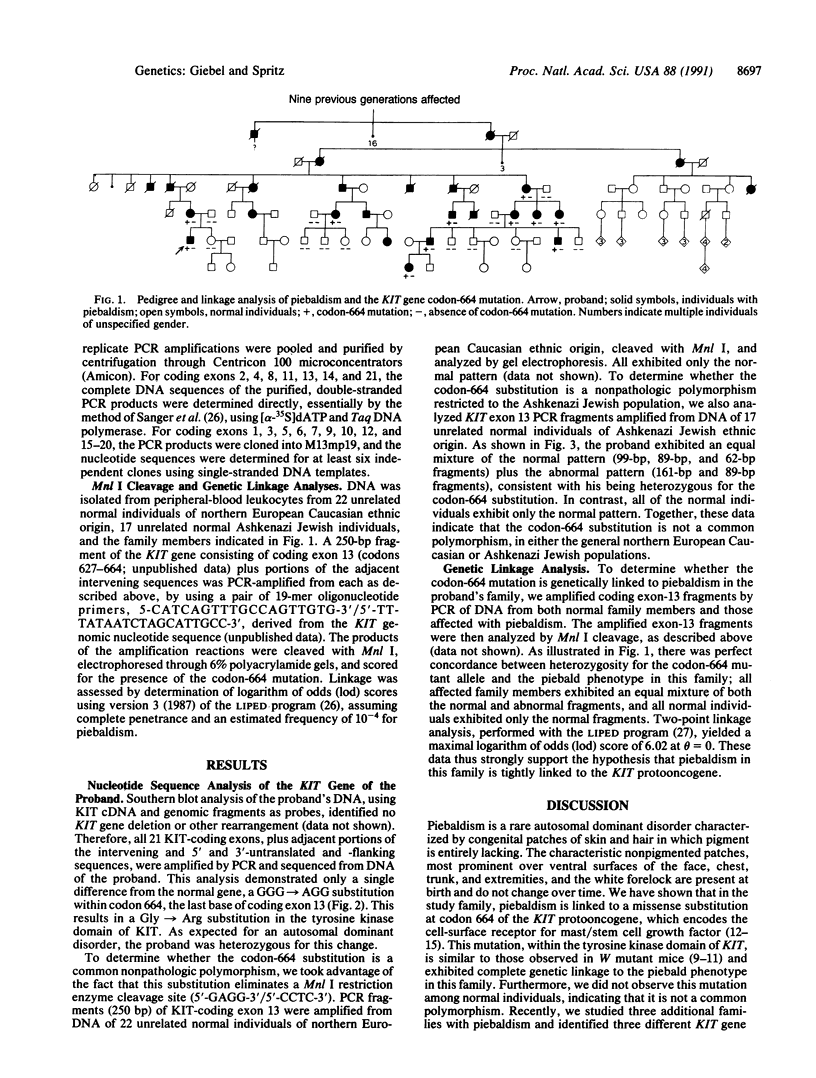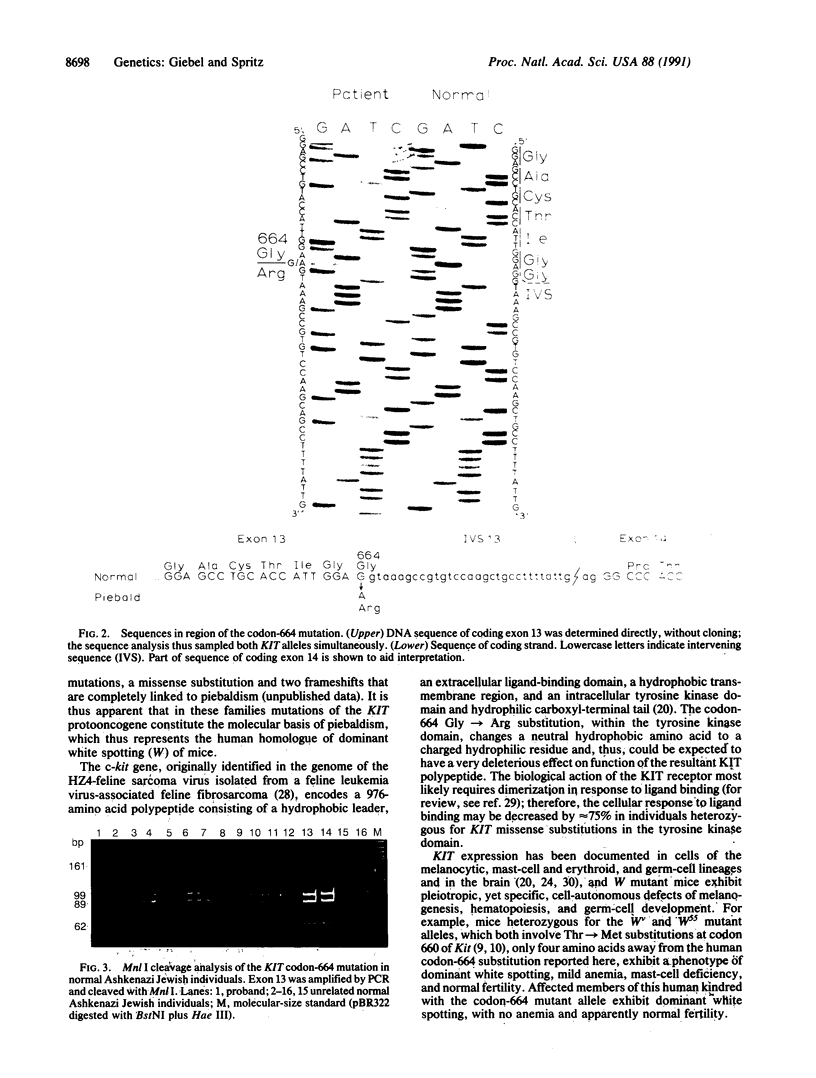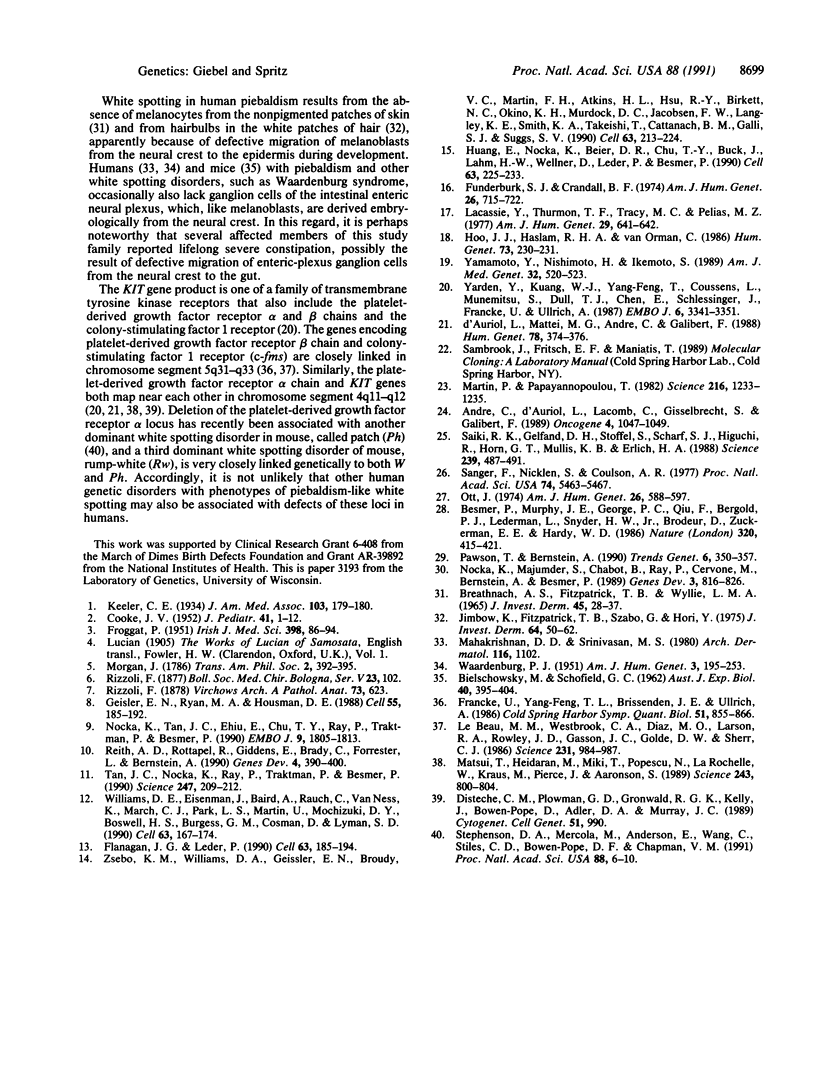Abstract
Piebaldism is an autosomal dominant genetic disorder characterized by cogenital patches of skin and hair from which melanocytes are completely absent. A similar disorder of mouse, dominant white spotting (W), results from mutations of the c-Kit protooncogene, which encodes and receptor for mast/stem cell growth factor. We identified a KIT gene mutation in a proband with classic autosomal dominant piebaldism. This mutation results in a Gly----Arg substitution at codon 664, within the tyrosine kinase domain. This substitution was not seen in any normal individuals and was completely linked to the piebald phenotype in the proband's family. Piebaldism in this family thus appears to be the human homologue to dominant white spotting (W) of the mouse.
Full text
PDF



Images in this article
Selected References
These references are in PubMed. This may not be the complete list of references from this article.
- André C., d'Auriol L., Lacombe C., Gisselbrecht S., Galibert F. c-kit mRNA expression in human and murine hematopoietic cell lines. Oncogene. 1989 Aug;4(8):1047–1049. [PubMed] [Google Scholar]
- Besmer P., Murphy J. E., George P. C., Qiu F. H., Bergold P. J., Lederman L., Snyder H. W., Jr, Brodeur D., Zuckerman E. E., Hardy W. D. A new acute transforming feline retrovirus and relationship of its oncogene v-kit with the protein kinase gene family. Nature. 1986 Apr 3;320(6061):415–421. doi: 10.1038/320415a0. [DOI] [PubMed] [Google Scholar]
- COOKE J. V. Familial white skin spotting (piebaldness) ("partial albinism") with white forelock. J Pediatr. 1952 Jul;41(1):1–12. doi: 10.1016/s0022-3476(52)80022-8. [DOI] [PubMed] [Google Scholar]
- Flanagan J. G., Leder P. The kit ligand: a cell surface molecule altered in steel mutant fibroblasts. Cell. 1990 Oct 5;63(1):185–194. doi: 10.1016/0092-8674(90)90299-t. [DOI] [PubMed] [Google Scholar]
- Francke U., Yang-Feng T. L., Brissenden J. E., Ullrich A. Chromosomal mapping of genes involved in growth control. Cold Spring Harb Symp Quant Biol. 1986;51(Pt 2):855–866. doi: 10.1101/sqb.1986.051.01.099. [DOI] [PubMed] [Google Scholar]
- Funderburk S. J., Crandall B. F. Dominant piebald trait in a retarded child with a reciprocal translocation and small intercalary deletion. Am J Hum Genet. 1974 Nov;26(6):715–722. [PMC free article] [PubMed] [Google Scholar]
- Geissler E. N., Ryan M. A., Housman D. E. The dominant-white spotting (W) locus of the mouse encodes the c-kit proto-oncogene. Cell. 1988 Oct 7;55(1):185–192. doi: 10.1016/0092-8674(88)90020-7. [DOI] [PubMed] [Google Scholar]
- Hoo J. J., Haslam R. H., van Orman C. Tentative assignment of piebald trait gene to chromosome band 4q12. Hum Genet. 1986 Jul;73(3):230–231. doi: 10.1007/BF00401233. [DOI] [PubMed] [Google Scholar]
- Huang E., Nocka K., Beier D. R., Chu T. Y., Buck J., Lahm H. W., Wellner D., Leder P., Besmer P. The hematopoietic growth factor KL is encoded by the Sl locus and is the ligand of the c-kit receptor, the gene product of the W locus. Cell. 1990 Oct 5;63(1):225–233. doi: 10.1016/0092-8674(90)90303-v. [DOI] [PubMed] [Google Scholar]
- Jimbow K., Fitzpatrick T. B., Szabo G., Hori Y. Congenital circumscribed hypomelanosis: a characterization based on electron microscopic study of tuberous sclerosis, nevus depigmentosus, and piebaldism. J Invest Dermatol. 1975 Jan;64(1):50–62. doi: 10.1111/1523-1747.ep12540914. [DOI] [PubMed] [Google Scholar]
- Lacassie Y., Thurmon T. F., Tracy M. C., Pelias M. Z. Piebald trait in a retarded child with interstitial deletion of chromosome 4. Am J Hum Genet. 1977 Nov;29(6):641–642. [PMC free article] [PubMed] [Google Scholar]
- Le Beau M. M., Westbrook C. A., Diaz M. O., Larson R. A., Rowley J. D., Gasson J. C., Golde D. W., Sherr C. J. Evidence for the involvement of GM-CSF and FMS in the deletion (5q) in myeloid disorders. Science. 1986 Feb 28;231(4741):984–987. doi: 10.1126/science.3484837. [DOI] [PubMed] [Google Scholar]
- Mahakrishnan A., Srinivasan M. S. Piebaldness with Hirschsprung's disease. Arch Dermatol. 1980 Oct;116(10):1102–1102. [PubMed] [Google Scholar]
- Martin P., Papayannopoulou T. HEL cells: a new human erythroleukemia cell line with spontaneous and induced globin expression. Science. 1982 Jun 11;216(4551):1233–1235. doi: 10.1126/science.6177045. [DOI] [PubMed] [Google Scholar]
- Matsui T., Heidaran M., Miki T., Popescu N., La Rochelle W., Kraus M., Pierce J., Aaronson S. Isolation of a novel receptor cDNA establishes the existence of two PDGF receptor genes. Science. 1989 Feb 10;243(4892):800–804. doi: 10.1126/science.2536956. [DOI] [PubMed] [Google Scholar]
- Nocka K., Majumder S., Chabot B., Ray P., Cervone M., Bernstein A., Besmer P. Expression of c-kit gene products in known cellular targets of W mutations in normal and W mutant mice--evidence for an impaired c-kit kinase in mutant mice. Genes Dev. 1989 Jun;3(6):816–826. doi: 10.1101/gad.3.6.816. [DOI] [PubMed] [Google Scholar]
- Nocka K., Tan J. C., Chiu E., Chu T. Y., Ray P., Traktman P., Besmer P. Molecular bases of dominant negative and loss of function mutations at the murine c-kit/white spotting locus: W37, Wv, W41 and W. EMBO J. 1990 Jun;9(6):1805–1813. doi: 10.1002/j.1460-2075.1990.tb08305.x. [DOI] [PMC free article] [PubMed] [Google Scholar]
- Ott J. Estimation of the recombination fraction in human pedigrees: efficient computation of the likelihood for human linkage studies. Am J Hum Genet. 1974 Sep;26(5):588–597. [PMC free article] [PubMed] [Google Scholar]
- Pawson T., Bernstein A. Receptor tyrosine kinases: genetic evidence for their role in Drosophila and mouse development. Trends Genet. 1990 Nov;6(11):350–356. doi: 10.1016/0168-9525(90)90276-c. [DOI] [PubMed] [Google Scholar]
- Reith A. D., Rottapel R., Giddens E., Brady C., Forrester L., Bernstein A. W mutant mice with mild or severe developmental defects contain distinct point mutations in the kinase domain of the c-kit receptor. Genes Dev. 1990 Mar;4(3):390–400. doi: 10.1101/gad.4.3.390. [DOI] [PubMed] [Google Scholar]
- Saiki R. K., Gelfand D. H., Stoffel S., Scharf S. J., Higuchi R., Horn G. T., Mullis K. B., Erlich H. A. Primer-directed enzymatic amplification of DNA with a thermostable DNA polymerase. Science. 1988 Jan 29;239(4839):487–491. doi: 10.1126/science.2448875. [DOI] [PubMed] [Google Scholar]
- Sanger F., Nicklen S., Coulson A. R. DNA sequencing with chain-terminating inhibitors. Proc Natl Acad Sci U S A. 1977 Dec;74(12):5463–5467. doi: 10.1073/pnas.74.12.5463. [DOI] [PMC free article] [PubMed] [Google Scholar]
- Stephenson D. A., Mercola M., Anderson E., Wang C. Y., Stiles C. D., Bowen-Pope D. F., Chapman V. M. Platelet-derived growth factor receptor alpha-subunit gene (Pdgfra) is deleted in the mouse patch (Ph) mutation. Proc Natl Acad Sci U S A. 1991 Jan 1;88(1):6–10. doi: 10.1073/pnas.88.1.6. [DOI] [PMC free article] [PubMed] [Google Scholar]
- Tan J. C., Nocka K., Ray P., Traktman P., Besmer P. The dominant W42 spotting phenotype results from a missense mutation in the c-kit receptor kinase. Science. 1990 Jan 12;247(4939):209–212. doi: 10.1126/science.1688471. [DOI] [PubMed] [Google Scholar]
- WAARDENBURG P. J. A new syndrome combining developmental anomalies of the eyelids, eyebrows and nose root with pigmentary defects of the iris and head hair and with congenital deafness. Am J Hum Genet. 1951 Sep;3(3):195–253. [PMC free article] [PubMed] [Google Scholar]
- Williams D. E., Eisenman J., Baird A., Rauch C., Van Ness K., March C. J., Park L. S., Martin U., Mochizuki D. Y., Boswell H. S. Identification of a ligand for the c-kit proto-oncogene. Cell. 1990 Oct 5;63(1):167–174. doi: 10.1016/0092-8674(90)90297-r. [DOI] [PubMed] [Google Scholar]
- Yamamoto Y., Nishimoto H., Ikemoto S. Interstitial deletion of the proximal long arm of chromosome 4 associated with father-child incompatibility within the Gc-system: probable reduced gene dosage effect and partial piebald trait. Am J Med Genet. 1989 Apr;32(4):520–523. doi: 10.1002/ajmg.1320320419. [DOI] [PubMed] [Google Scholar]
- Yarden Y., Kuang W. J., Yang-Feng T., Coussens L., Munemitsu S., Dull T. J., Chen E., Schlessinger J., Francke U., Ullrich A. Human proto-oncogene c-kit: a new cell surface receptor tyrosine kinase for an unidentified ligand. EMBO J. 1987 Nov;6(11):3341–3351. doi: 10.1002/j.1460-2075.1987.tb02655.x. [DOI] [PMC free article] [PubMed] [Google Scholar]
- Zsebo K. M., Williams D. A., Geissler E. N., Broudy V. C., Martin F. H., Atkins H. L., Hsu R. Y., Birkett N. C., Okino K. H., Murdock D. C. Stem cell factor is encoded at the Sl locus of the mouse and is the ligand for the c-kit tyrosine kinase receptor. Cell. 1990 Oct 5;63(1):213–224. doi: 10.1016/0092-8674(90)90302-u. [DOI] [PubMed] [Google Scholar]
- d'Auriol L., Mattei M. G., Andre C., Galibert F. Localization of the human c-kit protooncogene on the q11-q12 region of chromosome 4. Hum Genet. 1988 Apr;78(4):374–376. doi: 10.1007/BF00291740. [DOI] [PubMed] [Google Scholar]




